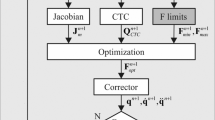Abstract
In this paper, an interdisciplinary combination of several state-of-the-art techniques from multibody dynamics, biomechanics, muscle modeling, optimal control, and visualization for the investigation of human motions is described. The goal is to use (wherever possible) and modify (wherever necessary) existing techniques and to investigate what has to be observed to make them work together efficiently. A separate investigation and implementation of the topics often is not sufficient for a combined approach, e.g., when some very sophisticated muscle models described in the literature yield infeasible computation times, even on modern supercomputers, if they are combined with optimal control techniques.
First, some basic elements of multibody dynamics and muscle models are described. Then, a state space model for the complete system is derived and optimal muscle stimulations are computed using optimal control techniques. Finally, extensions for the visualization of biomechanical effects are presented and the application to human kick and jump motions is shown. However, the main focus of the paper is the presentation of the interdisciplinary approach and its cooperating methods and not the in-depth description of individual topics or the investigation of a specific biomechanical application.
Similar content being viewed by others
References
Adrian, M.J. and Cooper, J.M., Biomechanics of Human Movement, Brown & Benchmark, Madison 1989.
Anderson, F.C., Ziegler, J.M., Pandy, M.G. and Whalen, R.T.,'Application of high-performance computing to numerical simulation of human movement', Journal of Biomechanical Engineering 117, 1995, 155–157.
Audu, M.L. and Davy, D.T., 'The influence of muscle model complexity in musculoskeletal motion modeling', Journal of Biomechanical Engineering 107, 1985, 147–157.
Audu, M.L.,'Optimal control modeling of lower extremity musculoskeletal motion', Ph.D. Thesis, Case Western Reserve University, 1985.
Blum, U., 'Beschreibung und Animation menschlicher Bewegungen', Master Thesis, Institutes A and B of Mechanics, University of Stuttgart, 1995.
Bock, H.G. and Plitt, K.J., 'A multiple shooting algorithm for direct solution of optimal control problems', in IFAC International Federation of Optimal Control, 9. World Congress, Budapest, 1984, 243–247.
Chow, C.K. and Jacobsen, D.H., 'Studies of human locomotion via optimal programming', Mathematical Biosciences 10, 1971, 88–92.
Davy, D.T. and Audu, M.L., 'A dynamic optimization technique for predicting muscle forces in the swing phase of gait', Journal of Biomechanics 20, 1987, 187–201.
Eberhard, P., NEWANIM-Animation von Mehrkörpersystemen, Manual AN-37, Institute B of Mechanics, University of Stuttgart, 1994.
Eberhard, P., Spägele, T. and Blum, U., Optimization of Human Movements, Video VB-17, Institute B of Mechanics, University of Stuttgart, 1995.
Eberhard, P., Zur Mehrkriterienoptimierung von Mehrkörpersystemen, VDI Fortschritt-Berichte, Reihe 11, Nummer 227, Düsseldorf, VDI Verlag, 1996.
Hatze, H., 'The complete optimization of human motion', Math. Bioscience 28, 1976, 99–135.
Huxley, A.F., 'Muscular contraction', Journal of Physiology 243, 1974, 1–43.
Jänsch, C., Schnepper, K. and Well, K.H., 'Multiphase trajectory optimization methods with application to hypersonic vehicles', in Applied Mathematics in Aerospace Science and Engineering, A. Miele and A. Salvetti (eds), Plenum Press, New York, 1994, Chapter 8.
Kraft, D., 'On converting optimal control problems into nonlinear programming problems', in Computational Mathematical Programming, K. Schittkowski (ed.), Springer-Verlag, Berlin, 1985, 261–280.
Kreuzer, E. and Leister, G., Programmsystem NEWEUL 92, Manual AN-32, Institute B of Mechanics, University of Stuttgart, 1991.
Metaxas, D.N., Physics-Based Deformable Models, Kluwer Academic Publishers, Boston, 1997.
Pandy, M.G., Anderson, F.C. and Hull, D.G., 'A parameter optimization approach for the optimal control of large-scale musculoskeletal systems', Transactions of the ASME 114, 1992, 450–460.
Pandy, M.G., Zajac, F.E., Sim, E. and Levine, W.S., 'An optimal control model for maximum-height human jumping', Journal of Biomechanics 23, 1990, 1185–1198.
Paul, B., OpenGL and Window System Integration, SIGGRAPH '97, Los Angeles, Course 24, 1997. (The software, documentation and examples are available at ftp://iris.ssec.wisc.edu/pub/Mesa.)
Schiehlen, W.O. (ed.), Multibody Systems Handbook, Springer-Verlag, Berlin, 1990.
Spägele, T., Modellierung, Simulation und Optimierung menschlicher Bewegungen, Ph.D. Thesis, Institute A of Mechanics, University of Stuttgart, 1996.
Tittel, K., Beschreibende und funktionelle Anatomie des Menschen, G. Fischer Verlag VEB, Jena, 1985.
Winters, J.M., 'Hill-based muscle models: A systems engineering perspective', in Multiple Muscle Systems: Biomechanics and Movement Organization, J.M. Winters and S. Woo (eds), Springer-Verlag, New York, 1990, 69–93.
Author information
Authors and Affiliations
Rights and permissions
About this article
Cite this article
Eberhard, P., Spägele, T. & Gollhofer, A. Investigations for the Dynamical Analysis of Human Motion. Multibody System Dynamics 3, 1–20 (1999). https://doi.org/10.1023/A:1009880222265
Issue Date:
DOI: https://doi.org/10.1023/A:1009880222265




